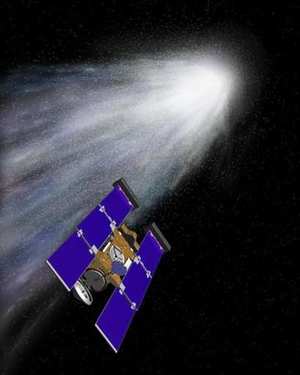Historic Spacecraft Returned From Comet Mission In 2006
Having returned the world's first particles from a comet, NASA's
Stardust sample return capsule will join the collection of flight
icons in the Smithsonian's National Air and Space Museum in
Washington. The capsule will go on public display in the museum's
Milestones of Flight Gallery on October 1, the 50th anniversary of
NASA.

Stardust, comprising a spacecraft and capsule, completed a
seven-year, 3-billion-mile journey in 2006A tennis racket-like,
aerogel-lined collector was extended to capture particles as the
spacecraft flew within 150 miles of comet Wild 2 in January
2004.
Carrying the collected particles,
the capsule returned to Earth on January 15,
2006, landing in Utah. Two days later, it was
transported to a curatorial facility at NASA's Johnson Space Center
in Houston.
"Very few people get to build something, launch it into space,
see it be successful and then get it back in their hands," said
Karen McNamara, Johnson recovery lead for the Stardust mission. "To
be able to share this with the public is phenomenal."
The capsule joins the Wright brothers' 1903 Flyer, Charles
Lindbergh's Spirit of St. Louis and the Apollo 11 command module
Columbia that carried the first men to walk on the moon.
"The Smithsonian Institution's National Air and Space Museum is
delighted to add to the National Collection the Stardust return
capsule," said Roger Launius, senior curator of the Division of
Space History at the museum. "As one of the premier space science
missions of the recent past, Stardust will take its place alongside
other iconic objects from the history of air and spaceflight. I
look forward to helping to impart more knowledge to our visitors
about the makeup of the universe using this significant and path
breaking object."
Hardware provided to the Smithsonian includes actual flight
components. Elements relevant to the science goals of the mission
remain with NASA.
After successfully completing its mission, Stardust will use its
flight-proven hardware to perform a new, previously unplanned
investigation. The mission, called Stardust-NExT, will revisit
comet 9P/Tempel 1. This investigation will provide the first look
at the changes to a comet nucleus produced after a close approach
to the sun. It also will mark the first time a comet ever has been
revisited.
"Usually, when a piece of your spacecraft goes into the
Smithsonian that means the mission's over," said Stardust-NExT
project manager Rick Grammier, of NASA's Jet Propulsion Laboratory
in Pasadena, CA. "But the Stardust spacecraft is still doing the
job for NASA and in February 2011, it will fly within 120 miles of
the comet."

Stardust is a low-cost, Discovery Program mission for NASA's
Science Mission Directorate. The Jet Propulsion Laboratory manages
the project. Joseph Veverka of Cornell University in Ithaca, NY is
the mission's principal investigator. Lockheed Martin Space Systems
of Denver manages mission operations.
 ANN's Daily Aero-Term (04.28.24): Airport Marking Aids
ANN's Daily Aero-Term (04.28.24): Airport Marking Aids Aero-News: Quote of the Day (04.28.24)
Aero-News: Quote of the Day (04.28.24) ANN's Daily Aero-Linx (04.28.24)
ANN's Daily Aero-Linx (04.28.24) Aero-News: Quote of the Day (04.29.24)
Aero-News: Quote of the Day (04.29.24) ANN's Daily Aero-Linx (04.29.24)
ANN's Daily Aero-Linx (04.29.24)




